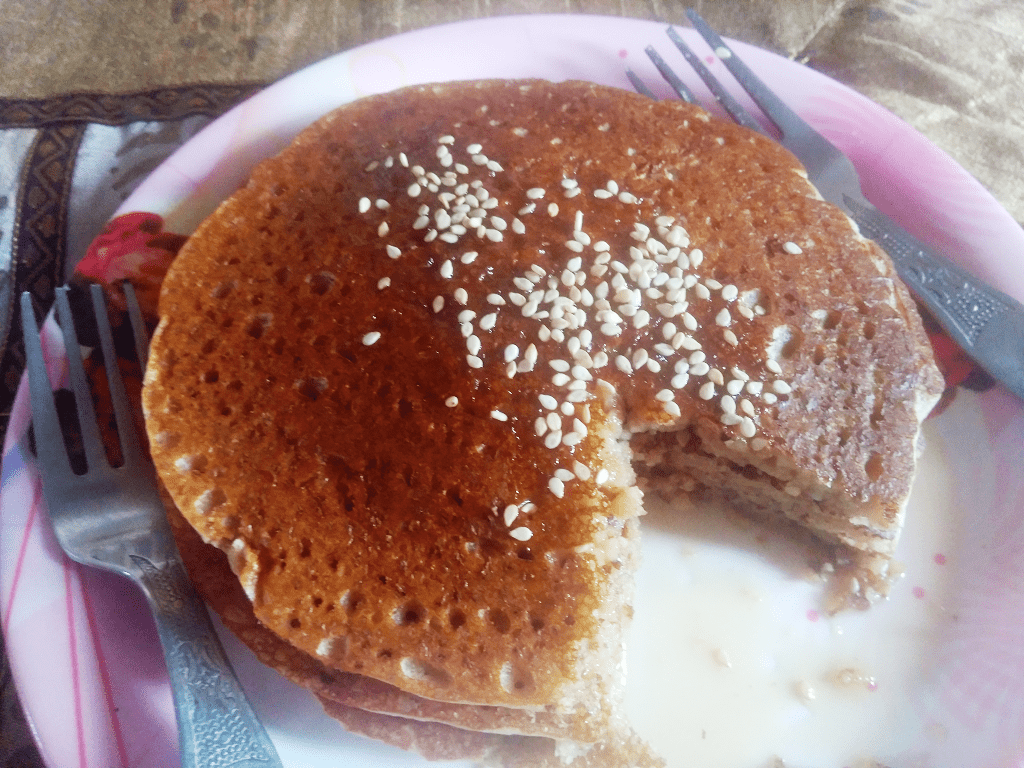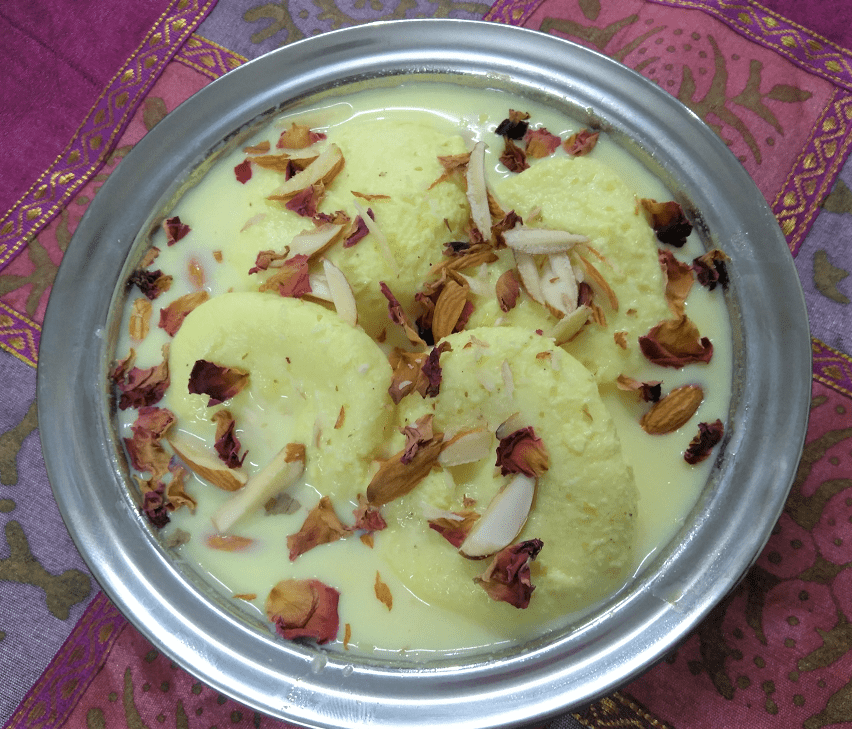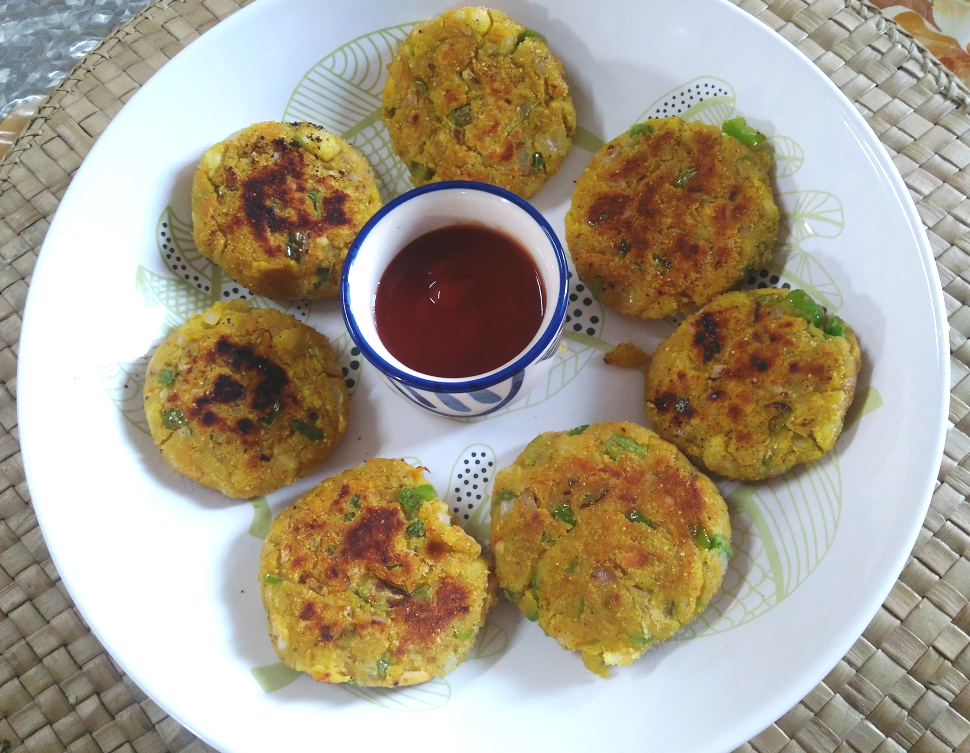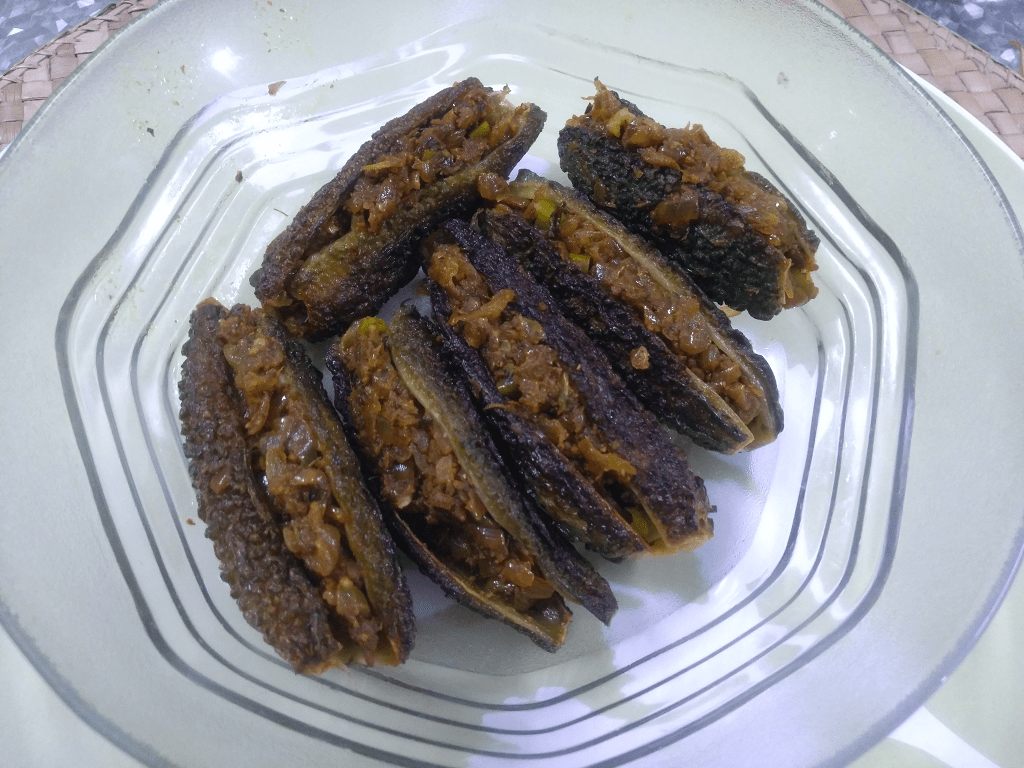Karele Aur Pyaj Ki Sabji | Easy Bitter Gourd Fry | Try out this no deep or shallow fried, bitterless karele ki sabji recipe. It is an gluten free, vegan, diabetic-friendly dry veg side dish.

About the Kerele ki sabji recipe
Karela or bitter gourd is a healthy vegetable and we should include it in our daily diet. But due to its bitter taste, a lot of people do not like them to eat.
Today, I am sharing a recipe of karele ki sabji that we will make without deep or shallow frying and it does not taste bitter.
It is easy to prepare and very tasty. To make this delicious sabji we need very less oil and can store it for about 10-12 days in the refrigerator in an airtight container. Whenever we want to eat, take out the required amount and warm it in the microwave for 1 minute and consume.
Karela sabji may not be everyone’s first choice due to its bitter taste, but trust me, with a few easy steps and the right combination of spices, you’ll discover a whole new world of flavors. We’re here to make the process easy and enjoyable.
To make this simple karela fry sabji I haven’t used ginger, garlic, tomato or amchoor(dry mango powder) which are basically used in making traditional bitter gourd recipes. I have used a secret ingredient that you will find below.
I have used here raw mango to give it a tangy as well as a sweet flavour. Becasue I use raw mango which is slightly turned yellow ripe. It gives it an amazing flavour to the karela fry sabji. If you use very raw mango this dish will get a bitter tangy flavour. So, it is your choice you can used raw mango or slightly ripe one mango.
Some other recipes from my blog that you would like to try
Also, I didn’t deep the karela to make this karela sabji very healthy. To keep it low in calories, I used roasting method to make this delicious kerala fry sabji. Defnitely, it will take little more time in cooking but believe me the end result is more satisfying and flavourful.
In this blog post, I’ll guide you through the preparation of karela sabji, sharing tips and techniques to minimize the bitterness while enhancing its taste. I useD a variety of aromatic spices and ingredients to create a well-balanced dish that will surprise your taste buds.
Beyond its unique flavor, karela offers a range of health benefits. It is packed with essential nutrients, antioxidants, and vitamins that contribute to overall well-being. It is known for its potential to help regulate blood sugar levels and aid digestion.
Whether you’re a karela lover or new to this vegetable, our karela sabji recipe will inspire you to give it a try. We’ll take you through each step, from prepping the karela to sautéing it with spices, resulting in a delicious dish that you’ll enjoy sharing with family and friends.
You can also enjoy low fat stuffed karela recipe that I have shared with you earlier.
Ingredients required for karele aur pyaj ki sabji
karela or bitter gourd– choose fresh, medium sized green coloured firm karela for making this dish. If you found hard seeds inside karela remove them.
Onion– improves taste and crunchiness of karela sabji.
Raw mango – instead of using tomato or dry mango powder I used raw mango which is slightly ripe to give this sabji an amazing taste.
Oil– used mustard oil for great taste and aroma.
Spices– salt, red chilli powder, turmeric powder, coriander powder, saunf powder they enhances taste and give this sabji a nice flavour.
This is a simple and delicious recipe from the heart of Indian cuisine.

Why should you try this karele ki sabji recipe
- Easy to cook
- Healthy & Nutritious
- Very less ingredients
- Diabetic-friendly
- Vegan
- Kids-friendly
How to store and what is the shelf life of karela aur pyaj ki sabji
To store karela fry sabji and maintain its freshness, follow these guidelines:
Refrigeration: Allow the karela fry sabji to cool down to room temperature before storing. Transfer it to an airtight container or a covered bowl. Place the container in the refrigerator to extend its shelf life.
Shelf Life: Karela fry sabji can be stored in the refrigerator for up to 10-12 days. It’s best to consume it within this time frame to enjoy its best flavor and texture.
Reheating: When you’re ready to eat the stored karela fry sabji, reheat it thoroughly before serving. You can do this in a microwave or on the stovetop by gently heating it until it’s heated through.
Freezing (Optional): If you want to extend the storage time, you can freeze the karela fry sabji. Transfer it to an airtight container or freezer-safe bag, ensuring there is minimal air trapped inside. Label the container with the date and place it in the freezer. Karela fry sabji can be stored in the freezer for up to 2-3 months.
Thawing and Reheating: When you’re ready to use the frozen karela fry sabji, thaw it in the refrigerator overnight. Once thawed, reheat it thoroughly before serving.
Remember, the texture of the karela may slightly change after refrigeration or freezing, but the flavors will still be delicious. It’s always recommended to consume freshly made karela aur pyaj ki sabji for the best taste and texture.
When consuming stored karela fry sabji, ensure that it smells and looks fresh. If it has an off smell or appearance, it’s best to discard it to avoid any food safety issues.
By following these storage guidelines, you can enjoy the karela fry sabji for a few days or even freeze it for longer-term storage, allowing you to savor its flavors at your convenience.
Health benefits of consuming karela or bitter gourd
Karela, also known as bitter gourd or bitter melon, offers several health benefits. While its unique bitter taste may not be preferred by everyone, it is worth considering incorporating karela into your diet due to its potential positive impact on health. Here are some of the health benefits of karela:
Blood Sugar Management: Karela has been traditionally used for its potential to help regulate blood sugar levels. It contains compounds that may help improve glucose metabolism and insulin sensitivity, making it beneficial for individuals with diabetes or those at risk of developing it.
Rich in Nutrients: Karela is low in calories but rich in essential nutrients. It contains vitamins like vitamin C, vitamin A, and vitamin K, as well as minerals such as iron, potassium, and magnesium. Including karela in your diet can help provide your body with these important nutrients.
Antioxidant Properties: Karela is a good source of antioxidants, which help protect the body against damage caused by harmful free radicals. The presence of antioxidants in karela may help reduce oxidative stress and inflammation in the body.
Digestive Health: The fiber content in karela can aid in digestion and promote a healthy digestive system. It prevents constipation, and improve overall gut health.
Weight Management: Due to its low calorie and high fiber content, karela can be a beneficial addition to a weight management diet. The fiber helps promote feelings of fullness and can aid in controlling appetite.
Skin Health: The presence of antioxidants and vitamins in karela can be beneficial for the skin. It may help improve skin health, promote a healthy complexion, and protect against skin damage caused by environmental factors.
Immune System Support: Karela contains immune-boosting properties that can help strengthen the immune system. The vitamins and antioxidants in karela may contribute to improved immune function and overall health.
It’s important to note that individual results may vary, and it’s always recommended to consult with a healthcare professional or nutritionist for personalized advice regarding your specific health needs.
Incorporating karela into your diet can be done through various preparations, such as stir-fries, curries, or soups. By combining it with other flavorful ingredients and spices, you can help balance its bitterness and enjoy the health benefits it offers.
Get ready to discover the magic that happens when bitter meets spices, and prepare to be pleasantly surprised by the flavors that await. Let’s dive in and enjoy the simplicity and deliciousness of this karela sabji recipe!
Step by step preparation of Karele Aur Pyaj Ki Sabji | Easy Bitter Gourd Fry
Prepare the Karela:
1.Wash the karela thoroughly and trim the ends. You can peel the skin if desired or leave it on for a slightly bitter taste. Slice the karela in ½ inch small rounds horizontally. Scrape out the seeds if they are hard otherwise leave them as it is.



2. If you prefer, you can also slice them into small, thin strips.
3. Sprinkle salt over the sliced karela and mix well. Allow it to sit for 1-2 hours. This helps to reduce the bitterness of the karela.
4. Squeeze out the excess moisture from the karela slices using your hands and discard the liquid.



Cooking the Karela Fry Sabji:
5. Heat oil in a pan over low medium heat.



6. Add squeezed karela slices, mix them well with oil so that each piece will coat with oil.
7. Now cook them on low medium heat sitrring occasionally in between for about 20-22 minutes or until the karela slice becomes crisps without any moisture left.
8. Take them out in a plate. Put the pan back to the flame.



9. Again heat mustard oil, add coarsely grounded coriander seeds powder, saunf powder, turmeric powder,red chilli powder, salt and mix them well. Roast for few seconds.
10. Add sliced onions and green chilies to the pan. Cover the pan and cook it for 1-2 minutes over low flame. Sauté until the onions turn golden brown.
11.Now add chopped raw mango, mix well and cover the pan again and cook further for 2-3 minutes so that mango is cooked well.



12. After that add roasted karela slices to the pan and mix well.
13. Reduce the heat to low and cover the pan. Allow the karela to cook for another 2-3 minutes or until they are tender and well-cooked, stirring occasionally.
14. Once the karela is cooked, remove the lid and cook for a few more minutes to let any excess moisture evaporate, giving it a slightly crispy texture.

Your Karele aur pyaj ki sabji (Karela Fry Sabji ) is now ready to be served! It makes a delicious side dish to accompany roti, rice, or any Indian meal. Enjoy the unique flavors of this nutritious and flavorful dish.
Serving suggestions
Karela fry can be served as a side dish or accompaniment to your main meal. It gives the best taste when it is serve along with chapatti and dal. Or you can easily serve it with rice and dal too.
It can be packed with paratha in the tiffin for lunch time.
Tips andr tricks
Look for firm and fresh karela with bright green skin. Avoid karela that has soft spots or wrinkles, as they may not taste as good.
- Sprinkling salt over the sliced karela and allowing it to sit for 1-2 hours surely helps to reduce the bitterness. Squeezing out the excess moisture from the karela after this step further helps in minimizing bitterness. So, Don’t skip this step.
- Adjust the amount of red chili powder according to your taste preferences. If you prefer a milder version, you can reduce the amount or skip it altogether.
- Sauté the onions until they turn golden brown. This helps to enhance their flavor and sweetness, balancing out the bitterness of karela.
- Cooking karela on low heat allows it to cook slowly and evenly, resulting in tender and well-cooked slices. This also gives the flavors time to develop and meld together.
- Make sure to mix the spices well with the karela slices, ensuring they are evenly coated. This ensures that the flavors are well distributed throughout the dish.
- Before serving, taste the sabji and adjust the seasoning if needed. You can add more salt, chili powder, or any other spices according to your preference.
Remember, karela fry sabji may still retain a slight bitterness even after these steps, as it is inherent to the vegetable. However, the combination of spices and other ingredients will help balance the flavors and make it delicious.
Recipe card

Karele Aur Pyaj Ki Sabji | Easy Bitter Gourd Fry
Ingredients
- 350 gm karela or bitter gourd
- 1 + 1 ½ tsp salt
- 4.5 tbsp mustard oil
- ½ tbsp coarse coriander powder
- ½ tbsp coarse saunf powder
- ½ tsp turmeric powder
- ¼ tsp garam masala
- 6-7 green chillies
- 3 medium sized onion sliced
- 1 small raw mango 70-100gm
Instructions
Prepare the Karela:
- Wash the karela thoroughly and trim the ends. You can peel the skin if desired or leave it on for a slightly bitter taste.
- Slice the karela in ½ inch small rounds horizontally. Scrape out the seeds if they are hard otherwise leave them as it is.
- If you prefer, you can also slice them into small, thin strips.
- Sprinkle salt over the sliced karela and mix well. Allow it to sit for 1-2 hours. This helps to reduce the bitterness of the karela.
- Squeeze out the excess moisture from the karela slices using your hands and discard the liquid.
Cooking the Karela Fry Sabji:
- Heat oil in a pan over low medium heat.
- Add squeezed karela slices, mix them well with oil so that each piece will coat with oil.
- Now cook them on low medium heat sitrring occasionally in between for about 20-22 minutes or until the karela slice becomes crisps without any moisture left.
- Take them out in a plate. Put the pan back to the flame.
- Again heat mustard oil, add coarsely grounded coriander seeds powder, saunf powder, turmeric powder,red chilli powder, salt and mix them well. Roast for few seconds.
- Add sliced onions and green chilies to the pan. Cover the pan and cook it for 1-2 minutes over low flame. Sauté until the onions turn golden brown.
- Now add chopped raw mango, mix well and cover the pan again and cook further for 2-3 minutes so that mango is cooked well.
- After that add roasted karela slices to the pan and mix well.
- Reduce the heat to low and cover the pan. Allow the karela to cook for another 2-3 minutes or until they are tender and well-cooked, stirring occasionally.
- Once the karela is cooked, remove the lid and cook for a few more minutes to let any excess moisture evaporate, giving it a slightly crispy texture.
- Your Karele aur pyaj ki sabji (Karela Fry Sabji ) is now ready to be served! It makes a delicious side dish to accompany roti, rice, or any Indian meal. Enjoy the unique flavors of this nutritious and flavorful dish.
Video
Notes
My latest video
Video link
Try this tasty karela fry sabji recipe at home and let me know about your outcomes in the comments section below or tag #healthicallykitchen on instagram. If you like this recipe, don’t forget to share it with your friends and family give us a 5 star rating.






